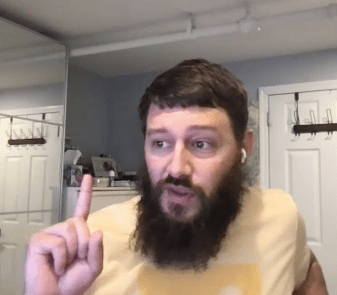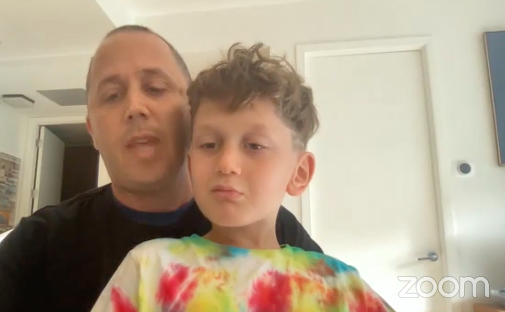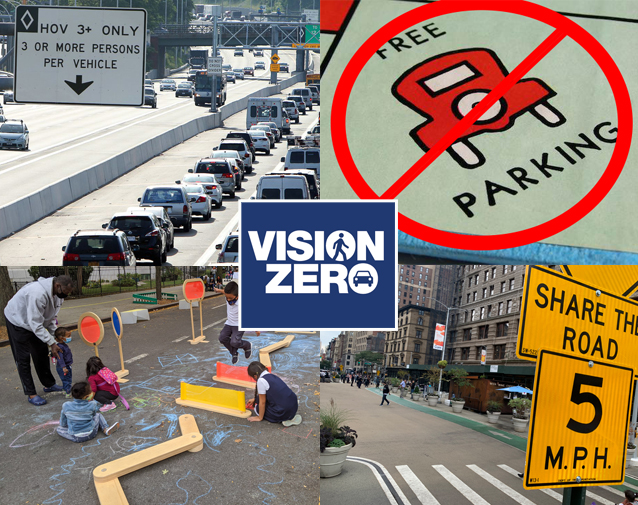The City Council's "oversight" hearing on Mayor de Blasio's Vision Zero initiative was a six-hour slog triumph of public involvement in the creation and implementation of policy, with dozens of people and lawmakers giving examples of the many ways in which the mayor's signature initiative has failed — and this year's death count provided an essential backdrop.
Obviously many people cited Streetsblog's recent investigation into the NYPD's failure to respond to many 311 complaints — what one man called "NYPD's 311 fraud" — while others testified in support of crucial council bills, such as Steve Levin's proposal to allow the public to report illegally parked cars (and pocket some of the ticket profits), Bob Holder's bill to ban license plate covers, Inez Barron's long-delayed bill to require stop signs at schools, and Ben Kallos's bill to decriminalize jaywalking (and therefore eliminate the NYPD's racially biased ticketing for this universal "crime").
And there was plenty of tearful testimony — including from the daughter of Ada Martinez, a cyclist killed in 2019 because of an illegally parked truck, and the wife of Jeffrey Williamson, who was killed earlier this year by a postal service driver — in support of such bills and other measures.
But what were the best ideas for actually fixing Vision Zero? Here's a summary:
1. Reduce parking

Following calls from just about everyone (including himself!), Jehiah Czebotar called for the Council to "require DOT to reduce on-street parking by 10 percent every year until the number of vehicles crossing bridges in New York City drops 50 percent [and] require DOT to expand the number of metered parking spaces by 10 percent each year until the city is no longer subsidizing car storage and the number of registered vehicles in NY drops by 50 percent." Others spoke of eliminating mandatory parking minimums that require developers to add parking to their projects.
Sara Lind, the director of policy at Open Plans, the livable streets nonprofit, pointed out some of the great public benefits to reducing parking: "Trash containerization; commercial loading zones; daylighting, neckdowns, and other safety improvements; bike corrals and bike share; public seating."
Bottom line? "Free parking is an impediment to street safety," added Choresh Wald.
A rather telling NYPD motivational poster at the Brooklyn tow pound pic.twitter.com/ZEOxsBLxU6
— Liam Quigley (@_elkue) October 25, 2021
2. Require carpooling
Multiple people and organizations testified in support of carpool lanes on city bridges to require every car to be carrying at least three people inside it. Czebotar's testimony called for "HOV lanes on all bridges and major routes," while mega-coalition that includes Riders Alliance, StreetsPAC, Regional Plan Association, Transportation Alternatives and others only called for HOV lanes during "gridlock and air quality 'alert' days," a huge miss.
3. Encourage e-bikes and be skeptical of e-cars
Czebotar called for a publicly funded e-bike and e-scooter rebate program, while Lind used her written testimony to call for "charging stations for e-bikes and other electric mobility devices on public streets."
Meanwhile, Jaqi Cohen of Tri-State Transportation Campaign made sure that lawmakers don't fool themselves into thinking electrifying the American vehicle fleet will solve the majority of our society's problems.
"Vehicle electrification is not a silver bullet solution to fighting climate change while making New York a more equitable city," she said. "Electrification doesn’t speed up New York City’s buses, which are the slowest in the country. It doesn’t reduce the threat of traffic violence which has led to the deadliest year on our streets since Vision Zero was first adopted. Electrification itself will not achieve New York’s climate goals without also implementing complementary policies that seek to reduce vehicle miles traveled on the City’s streets."
4. Protect our kids
It's outrageous that 50,000 city teachers get parking placards, which encourage them to drive to school, a mode choice makes the streets more dangerous for everyone, said Lisa Orman of Open Plans. But what's worse is that the streets in front of those schools are generally open to traffic all day long.
"Only about 100 out of the nearly 2,000 schools in the city have some sort of 0pen street," Orman said. "We need the DOT and the Department of Education to implement these at every single school, starting with the schools with the most dangerous streets around them."
As an irony, Orman pointed out that the city was very quick to create restaurant streets to save an important industry, but are not our kids equally important, she asked.
"If we can completely change the streets to accommodate restaurants, how can we not do the same for our kids?" she said. "By changing the culture around how students get to and from school, we get that much closer to Vision Zero." She also cited seminal Streetsblog coverage that proved that open streets are safer; on the 34th Avenue open street in Queens, for example, crashes dropped 85 during open street hours.
"This is a corridor with seven schools servicing 8,800 students," she said. "Imagine if we had an open street in front of every school in the city!"
"If you're hiding your plate, you're probably committing other crimes as well." @BobHoldenNYC
— Open Plans (@OpenPlans) October 26, 2021
5. Get serious about impounding the cars of reckless drivers
Lind, a former City Council candidate, focused her testimony on the failure of the city to prevent crashes like the one that killed Baby Apolline Mong-Guillemin because a repeat recidivist reckless driver was never taken off the road, despite multiple license suspensions, more than enough tickets to warrant a towing, and close to 100 moving violations.
"For the worst offenders, we need to go beyond just suspending their licenses and impound their cars. Driving is a privilege, not a right. Lives are at stake," she testified. "This Council should amend [the Dangerous Vehicle Abatement Act] to call for impounding vehicles if drivers continue to break the law after taking the course. In the meantime, we urge the Sheriff’s office to boot and tow more of these cars. The Council should use its oversight capacity to ensure that the Sheriff is prioritizing booting and towing the worst offenders. While sting operations get media coverage, it’s not clear why the Sheriff does not do this all the time."
DOT Commissioner Hank Gutman also supported more towing, but his Vision Zero partner at NYPD, Transportation Bureau Chief Kim Royster admitted that NYPD diverted resources from traffic violence towards shootings and other crimes during a recent uptick in such crimes. Richard Robbins, an Upper West Sider, said such a diversion of resources shows that the NYPD is not committed to reducing road violence.
6. Reimagine the role of 'engineering' at DOT
Echoing thoughts from Streetsblog Publisher Mark Gorton in an op-ed this week, many speakers addressed the fundamental problem with DOT: it is an agency that primarily focuses on moving cars.
"We encourage the Council to hold an oversight hearing on the traffic engineers at DOT and whether they are fulfilling DOT’s stated mission of prioritizing safety," Lind said. "As it now stands, current engineering certifications used as tools of authority by the engineering staff are being wielded improperly to prioritize the movement of vehicles over the safety of humans. By starting with traffic flow, the traffic engineers have developed a methodology that specifically excludes the inevitable human cost of their designs. The concept of desired throughput needs to be banned from use at DOT and engineers must be held to account for the unsafe conditions they create."
Eric McClure of StreetsPAC added that "Vision Zero needs to be properly implemented, with a much greater emphasis on street design."
"Redesigning streets to make human error less costly requires a heavy dose of political will, a will that’s been lacking in New York City’s version of Vision Zero," he added. "The will to physically force drivers to slow down and accept that their convenience cannot come at the cost of life, limb, and quality of life for New York’s non-driving majority. The will to invest in concrete curb extensions for people on foot, and concrete barriers for people on bikes. ... The will to tell people that a daylighted intersection, and the life it may save, is more important than a couple of free parking spaces."
Christine Berthet, the legendary Hells Kitchen pedestrian advocate, said Vision Zero requires DOT to annually identify the 25 most dangerous intersections and make them as safe as possible during that same year, but the agency keeps failing.
"The key words are 'as safe as possible,'" she said. "While the planners are pushing for more safety, DOT engineers decide whether a safety feature is taking too much space or too much time away from cars. This is why currently at intersections, traffic signals provide six times — six times! — more protection to cars than to cyclists or pedestrians. When we ask for protection, we are given five seconds of safe crossing to preserve traffic flow. … They are rationing our safety."
She also noted that Gutman repeatedly cited federal guidelines for why his agency does not install stop signs are dangerous intersections — federal guidelines that recommend such traffic control only after injuries.
"I'd like to challenge DOT commissioner on his deference to the engineers and their use of the federal guidelines, which are only that – guidelines. ... This manual says that you should wait until five people have been injured to fix an intersection! There is no legal or moral basis to follow such highway-centric guidelines."
7. Public space management
Many speakers addressed the inequity of how public space is made safe for some New Yorkers, but not others. Open Plans has been pushing for an "Office of Public Space Management" so that the public realm is not dependent on a business improvement district or private partner."
Such an agency, for example, would oversee public space rather than the current situation: the city relies on private organizations to carry the liability and maintenance for street safety improvementssuch as curb extensions or bike corrals.
"The DOT requires maintenance partners for critical safety infrastructures, such as bump-outs," said Jackson Chabot of Open Plans. "Therefore, if there isn’t a partner, there isn’t going to be the safety improvement. This leads to inequitably distributed infrastructure across the city" because "wealthy BIDs are leading the way on pedestrian safety."
8. Police are needed sometimes
Council Member Kalman Yeger, who has never been a leader in street safety issues, referred to a decision in 2020, widely covered by Streetsblog, to have police no longer routinely respond to reported crashes if there are no injuries. As Streetsblog mentioned at the time, some street safety advocates were concerned that such crashes might not end up in any statistical databases or on the radar of DOT without police response.
"Police need to go back to responding to crashes so we have the data and so we are taking bad drivers off the street," Yeger said, noting that only the presence of a police officer can lead to an arrest if a driver is operating a car without a valid license or has violated a driving rule in the seconds before the crash.
Gutman focuses largely on topics outside of his agency's remit like drivers with suspended licenses (DMV), an increase in for-hire vehicles (TLC), and expanding speed camera programs (state legislature)
— Kevin Duggan (@kduggan16) October 26, 2021
9. Truly end placard abuse
The de Blasio administration has long talked about placard abuse, but expanded the distribution of them and then failed to crack down on misuse of them.
Czebotar went for a true zero tolerance policy, arguing that a city employee who "parks on a sidewalk" should lose his or her job. He also argued that DOT should be "the only city agency to issue parking placards or permitting for on-street parking" (currently, so many agencies issue legit placards that fake placards are hard to discern).
The keepers of the Placard Abuse Twitter account also testified in writing about the myriad problems with fake placards created by agencies or people who should not be legally authorized to create them: "Why are the unions that represent members of the NYPD, FDNY, Probation and other departments allowed to produce their own fake placards that are designed to appear like they were issued by city agencies?"
The large Riders Alliance/TA coalition added that "the special parking privileges afforded to city workers and other VIPs" — which the group estimated as "upwards of 125,000 placards" — creates "immeasurable waste, fraud, and abuse of authority."
And the result is choked streets, thanks to cars being left in places where DOT did not design for car storage. As Council Member Steve Levin put it, "You can't throw a tennis ball in Downtown Brooklyn without hitting an illegally parked car with a placard."
Michelle Kuppersmith also targeted cops: "The NYPD cannot be on the front lines of enforcement — they're the ones who are breaking the law."
10. Don’t forget kids

Street safety activist Doug Gordon yielded his time to his 8-year-old son, Zeb, who spoke eloquently about how dangerous his neighborhood streets are.
"Dangerous drivers sometimes just look at their phones and that is dangerous because drivers just zoom across a red light and some people might be walking," said the Park Slope savant.
"So if there were fewer cars it would be safer! If cars were limited I could bike to school more often and there wouldn’t be so much climate change."
And here's one we didn't hear
Every member of the Council should give up his car, City Hall parking space and placard to lead by example and show that our elected officials are willing to be occasionally inconvenienced in order to save lives, speed bus riders and reduce pollution that is causing climate change.
Did we miss anything? Please put your testimony in the comments below.






